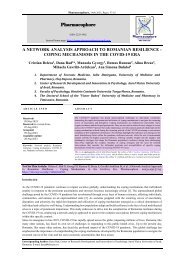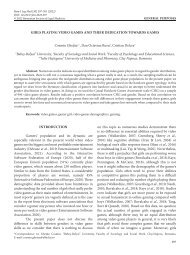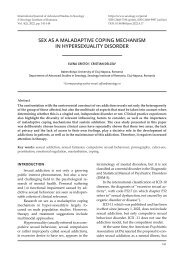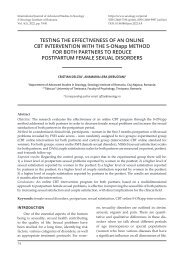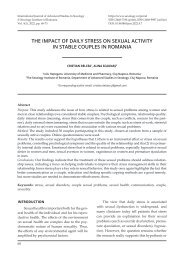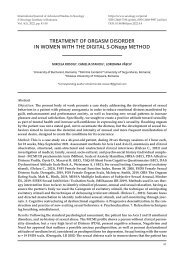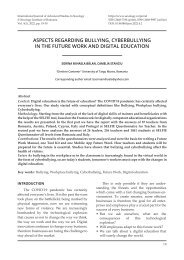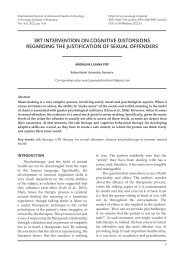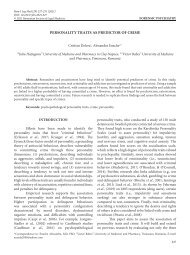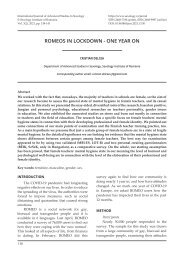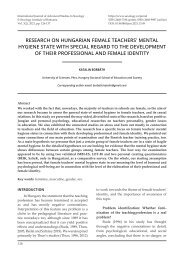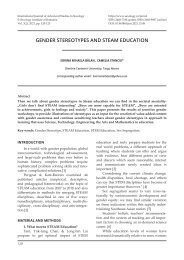Transtheoretical Issues on Internalized Paraphilic Disorders
When a diagnosis for paraphilia is established, one needs to take into consideration that these behaviours take place over a period of at least 6 months or that fantasies, impulses and sexual behaviours cause the individual a significant social, professional or other important disability. A controversial aspect regarding the paraphilic diagnosis is the relationship between sexual fantasies and concrete behaviour, which may or may not exist according to different research studies. People have sexual fantasies that they do not always or even never realize, thus being completely different than those who adopt concrete behaviour. Several studies demonstrate that there is a wide variety of sexual fantasies among the general population. Therefore, the scope of this paper is to address and underline, from a transtheoretical point of view, internalized paraphilic disorders as: exhibitionism, voyeurism, sadism, masochism and fetishism.
When a diagnosis for paraphilia is established, one needs to take into consideration that these
behaviours take place over a period of at least 6 months or that fantasies, impulses and sexual
behaviours cause the individual a significant social, professional or other important disability.
A controversial aspect regarding the paraphilic diagnosis is the relationship between sexual
fantasies and concrete behaviour, which may or may not exist according to different research
studies. People have sexual fantasies that they do not always or even never realize, thus being
completely different than those who adopt concrete behaviour. Several studies demonstrate that
there is a wide variety of sexual fantasies among the general population. Therefore, the scope
of this paper is to address and underline, from a transtheoretical point of view, internalized
paraphilic disorders as: exhibitionism, voyeurism, sadism, masochism and fetishism.
You also want an ePaper? Increase the reach of your titles
YUMPU automatically turns print PDFs into web optimized ePapers that Google loves.
<str<strong>on</strong>g>Transtheoretical</str<strong>on</strong>g> <str<strong>on</strong>g>Issues</str<strong>on</strong>g> <strong>on</strong> <strong>Internalized</strong> <strong>Paraphilic</strong> <strong>Disorders</strong><br />
DELCEA Cristian 1<br />
1<br />
“Iuliu Hațieganu” University of Medicine and Pharmacy, Cluj-Napoca (ROMANIA)<br />
Email: cristian.delcea.cj@gmail.com<br />
Citati<strong>on</strong>: Delcea C., (2020). „<str<strong>on</strong>g>Transtheoretical</str<strong>on</strong>g> <str<strong>on</strong>g>Issues</str<strong>on</strong>g> <strong>on</strong> <strong>Internalized</strong> <strong>Paraphilic</strong> <strong>Disorders</strong>”. Proceedings Of The<br />
Internati<strong>on</strong>al C<strong>on</strong>ference <strong>on</strong> Legal Medicine from Cluj, 3rd editi<strong>on</strong> Vol. 2 (Cluj-Napoca, Romania, 1-4 October 2020).<br />
Editors: Costel Vasile Siserman and Cristian Delcea. Pp. 71-78. Filodiritto Publisher. DOI: 10.26352/Ex01bis_Legal-<br />
Medicine_Vol.2-2020<br />
Abstract<br />
When a diagnosis for paraphilia is established, <strong>on</strong>e needs to take into c<strong>on</strong>siderati<strong>on</strong> that these<br />
behaviours take place over a period of at least 6 m<strong>on</strong>ths or that fantasies, impulses and sexual<br />
behaviours cause the individual a significant social, professi<strong>on</strong>al or other important disability.<br />
A c<strong>on</strong>troversial aspect regarding the paraphilic diagnosis is the relati<strong>on</strong>ship between sexual<br />
fantasies and c<strong>on</strong>crete behaviour, which may or may not exist according to different research<br />
studies. People have sexual fantasies that they do not always or even never realize, thus being<br />
completely different than those who adopt c<strong>on</strong>crete behaviour. Several studies dem<strong>on</strong>strate that<br />
there is a wide variety of sexual fantasies am<strong>on</strong>g the general populati<strong>on</strong>. Therefore, the scope<br />
of this paper is to address and underline, from a transtheoretical point of view, internalized<br />
paraphilic disorders as: exhibiti<strong>on</strong>ism, voyeurism, sadism, masochism and fetishism.<br />
Keywords: paraphilic disorders, paraphilia, exhibiti<strong>on</strong>ism, voyeurism, sadism, masochism and fetishism<br />
1. Introducti<strong>on</strong><br />
A clear definiti<strong>on</strong> of paraphilia is difficult to provide due to the fact that so far it has not been<br />
possible to draw a clear line between normal and pathological, when it comes to sexual<br />
behaviour. This issue is represented by the evoluti<strong>on</strong> of sexual interests over time and of cultural<br />
diversity.<br />
However, paraphilia is still characterized as being the sexual interest in atypical or extreme<br />
objects, situati<strong>on</strong>s, targets. It can appear around an object (child, animal, underwear) or an act<br />
(causing pain or self-exposure). According to DSM-5 and ICD-10, the most comm<strong>on</strong> types of<br />
paraphilia are: voyeurism; exhibiti<strong>on</strong>ism; frotteurism; transvestite fetishism; sadism;<br />
masochism; and paedophilia [1], [2].<br />
The objective of this paper is thus to underline and summarize some ideas <strong>on</strong> internalized<br />
paraphilic disorders, the <strong>on</strong>es being analysed here being: exhibiti<strong>on</strong>ism, voyeurism, sadism,<br />
masochism and fetishism.<br />
2. Exhibiti<strong>on</strong>ism<br />
Exhibiti<strong>on</strong>ism is defined as the exposure of the genitals to strangers in order to obtain intense<br />
sexual arousal, characterized by fantasies, sexual impulses or specific behaviours [1], [3] and<br />
[4].<br />
Another definiti<strong>on</strong> states that exhibiti<strong>on</strong>ism is a type of human behaviour characterized by<br />
the inclinati<strong>on</strong> or the impulse to manifest in public through indecent acts, attitudes or gestures.<br />
From a medical point of view, exhibiti<strong>on</strong>ism is <strong>on</strong>e of the symptoms of deviant sexual<br />
behaviour, [1] in the category of hypersexuality.
2.1 Research and statistic data<br />
A relatively small percentage of exhibiti<strong>on</strong>ists speak about experiences of sexual and<br />
physical abuse during childhood. Thus, the studies realized by Sauders and Awad menti<strong>on</strong> 17%<br />
cases of sexual abuse during childhood and 9-10% cases of physical abuse in the case of<br />
exhibiti<strong>on</strong>ists [3].<br />
Studies show that, although exhibiti<strong>on</strong>ism is better known am<strong>on</strong>g men, an increased rate of<br />
this phenomen<strong>on</strong> has also been reported am<strong>on</strong>g the female populati<strong>on</strong>. A study <strong>on</strong> the behaviour<br />
of people suffering from exhibiti<strong>on</strong>ism and voyeurism am<strong>on</strong>g the Swedish populati<strong>on</strong>, found a<br />
fairly high rate of exhibiti<strong>on</strong>ism am<strong>on</strong>g women – 31.6%, a sample of 1171 women aged 18-60<br />
years [4].<br />
2.2 Theories<br />
2.2.1 The factorial model<br />
The family envir<strong>on</strong>ment, biological factors and cultural factors, can increase the individual’s<br />
psychological vulnerability leading to issues such as: sexual patterns, inadequate emoti<strong>on</strong>s,<br />
intimate deficits, cognitive diss<strong>on</strong>ance [5]. All these factors interact in different ways and modes<br />
of aggressi<strong>on</strong> differ from individual to individual [6].<br />
2.2.2 Freud’s Theory<br />
According to this theory, exhibiti<strong>on</strong>ists are individuals blocked <strong>on</strong> the stage of n<strong>on</strong>-physical<br />
interacti<strong>on</strong> of choosing a partner [6]. The stages identified in the c<strong>on</strong>structi<strong>on</strong> of a relati<strong>on</strong>ship<br />
(according to the theory supported by Freud) are:<br />
a) Identificati<strong>on</strong> of a possible partner;<br />
b) N<strong>on</strong>-physical interacti<strong>on</strong>s (dialogue, discussi<strong>on</strong>, flirting, courtship);<br />
c) Mutual touch;<br />
d) Sexual activity (vaginal sex). [5]<br />
Different types of exhibiti<strong>on</strong>ism are described and presented in Table 2.1.<br />
Paraphilia<br />
Agoraphilia<br />
Agrexophilia<br />
Anasyrma<br />
Autoscopophilia<br />
Flashing<br />
Mo<strong>on</strong>ing<br />
Peodeiktophilia<br />
Table 2.1 Form of exhibiti<strong>on</strong>ism [7]<br />
Focus of erotic interest<br />
Intimate exposure in public space and performance the sexual act in public<br />
Sexual pleasure and orgasm depend <strong>on</strong> the c<strong>on</strong>text in which the individuals having<br />
intercourse are listened to/heard by <strong>on</strong>e or more pers<strong>on</strong>s<br />
The exposure genitals by lifting up the skirt – in the case of women – or taking off pants<br />
– in the case of men – when the pers<strong>on</strong> in questi<strong>on</strong> is not wearing underwear<br />
The c<strong>on</strong>templati<strong>on</strong> of <strong>on</strong>e’s own body, especially the genitals<br />
He exposure of the breast area or the genitals in public<br />
The pleasure of showing off <strong>on</strong>es back area<br />
The pleasure of causing a shock or panic to an unknown pers<strong>on</strong> by showing <strong>on</strong>e’s penis<br />
3. Voyeurism<br />
Voyeurism refers to the acti<strong>on</strong> of watching an unknown or lesser-known pers<strong>on</strong> who is<br />
undressed, who is about to undress or engage in sexual activity.<br />
The acti<strong>on</strong> of watching has the purpose of obtaining sexual arousal and satisfacti<strong>on</strong> and in<br />
general, the definiti<strong>on</strong> doesn’t include the c<strong>on</strong>sidering of performing the sexual act with the<br />
people watched. [8]<br />
People bel<strong>on</strong>ging to these categories can reach the peak of orgasm by masturbating and<br />
staring at a distance and imagining their own fantasy with the subject, without touching him/her,<br />
without the need to interact effectively with the pers<strong>on</strong> watched. At the same time, if the subject
is “orgasmic” enough, this will be used by the voyeur <strong>on</strong> other occasi<strong>on</strong>s (later) to recall<br />
observed fantasies.<br />
People who suffer from this type of paraphilia, often prefer to observe the subject from a<br />
distance, usually sneaking (of hiding); in order to do this, they are usually very well equipped,<br />
possessing different instruments to help them: binoculars, cameras, photo cameras.<br />
At other times, probably in order to fulfil their fantasies (the bravest, who need adrenaline)<br />
can take more risks, peeping through the keyhole or any other holes made in the walls, through<br />
which they can follow the “show” <strong>on</strong> the other side, or by approaching other strategies. [9]<br />
3.1 Psychoanalytic theories<br />
Freud described voyeurism as an exacerbati<strong>on</strong> of the scopofilic instinct, c<strong>on</strong>sidered normal<br />
and which is usually expressed in sexual activity [10]. The desire for a defensive mechanism<br />
against anxiety caused by genital c<strong>on</strong>tact is also added in the definiti<strong>on</strong> [11].<br />
Three factors are essential in the development of this disorder:<br />
a) Hyper-cathexis – exacerbated investment of libido/interest in an object, pers<strong>on</strong> or<br />
idea; exacerbati<strong>on</strong> of the sense of sight [12];<br />
b) Postnatal experiences that involved visual exchanges with the mother, [13] doubled<br />
by fear of loss of the mother and the breast; the fear of castrati<strong>on</strong>, which has its origin<br />
in the observati<strong>on</strong> of the adult genitals. Voyeurism becomes for the subject a way to<br />
recall the past, trying to reproduce the most pleasant or terrifying experiences,<br />
gaining much desired c<strong>on</strong>trol over them;<br />
c) Traumas from the first two years of life that weaken the mother-child relati<strong>on</strong>ship.<br />
These traumas underlie the problems of sexual identity and the splits between Ego<br />
and Superego [3].<br />
3.2 Social learning theories<br />
The authors Laws and Marshall c<strong>on</strong>sider that the patterns of sexual arousal of an individual<br />
are the product of c<strong>on</strong>diti<strong>on</strong>ing. In other words, the way in which sexual behaviour is<br />
c<strong>on</strong>structed, such as a map of sexual attracti<strong>on</strong>, does not differ much from the way in which any<br />
behaviour is acquired. [14]<br />
3.2.1 Freud’s theory (courtship disorder theory)<br />
According to Freud’s theory, paraphilias fall under legal incidence [15], and the voyeur is<br />
fixed <strong>on</strong> the first stage of choosing a partner (the <strong>on</strong>e who sees/observes a potential partner), a<br />
stage that s/he fails to overcome [5].<br />
3.2.2 Biological theories<br />
These theories menti<strong>on</strong> the role of impulse from a physiological perspective, rather than<br />
from a motivati<strong>on</strong>al perspective [5].<br />
The types of voyeurism have been summarized in Table 3.1.<br />
Table 3.1 Types of voyeurism [5]<br />
Paraphilia<br />
Focus of erotic interest<br />
Amomaxia<br />
Performing sexual intercourse or other erotic games in the car<br />
Ecoteurism<br />
Listening, without permissi<strong>on</strong>, other people who have sexual relati<strong>on</strong>s<br />
Mixoscopia bestialis Watching people having sexual relati<strong>on</strong>s with un animal [16]<br />
Mixoscopic zoophilia Watching animals having sexual relati<strong>on</strong>s [16]<br />
Scopophilia<br />
Watching other people engaged in sexual acts/activities, with the c<strong>on</strong>sent of the<br />
pers<strong>on</strong>s observed
4. Masochism<br />
The term masochism was first menti<strong>on</strong>ed by the Austrian novelist Leopold v<strong>on</strong> Sacher-<br />
Masoch, who described in the novel “Venus dressed in furs”, the sufferings and humiliati<strong>on</strong>s to<br />
which a man in the hands of a domineering woman is subjected [4].<br />
Krafft-Ebing is the <strong>on</strong>e who described sexual masochism, detaching it from stigma and<br />
making it the subject of scientific research. He is the first to provide a detailed descripti<strong>on</strong> of<br />
this type of behaviour and pointed out that, unlike most paraphilias, masochism is more<br />
comm<strong>on</strong> in women, but does not specify that it can occur in homosexuals [7], [17].<br />
Freud describes this paraphilia as: the individual’s characteristic who experiences pleasure<br />
by generating pain in others during sexual intercourse and who is also able to experience pain<br />
in sexual intercourse to the same extent as pleasure – sadomasochism.<br />
Moral masochism means the pers<strong>on</strong>ality that c<strong>on</strong>stantly makes repeated unfavourable<br />
decisi<strong>on</strong>s, thus causing suffering, which is why, in many works, the term masochism is often<br />
used to describe such behaviour, having no sexual c<strong>on</strong>notati<strong>on</strong>s [4].<br />
In ICD 10, the term sadomasochism refers to the fact that the individual obtains sexual<br />
arousal and satisfacti<strong>on</strong> from both sadistic and masochistic activities [2].<br />
In DSM IV, the two c<strong>on</strong>cepts are treated separately, stating that in order to be diagnosed, the<br />
individual must have intense and recurrent sexually aroused fantasies for a period of at least 6<br />
m<strong>on</strong>ths, as well as sexual impulses.<br />
Masochism is a sexual deviance and falls within the area of paraphilias. The term is used to<br />
describe the pers<strong>on</strong>ality disorder.<br />
Sexual masochism refers to the situati<strong>on</strong> in which the individual is humiliated, beaten, tied<br />
up, and tortured, physically or morally abused [1]. Sexual masochism, as form of manifestati<strong>on</strong>,<br />
can <strong>on</strong>ly be at the level of phantasmagoria, transposed into the activity of the couple and in the<br />
solitary sexual activity:<br />
• Fantasizing – fantasies that refer to being raped by other people while being hit or tied<br />
to others etc.; fantasies said during sexual activity but without taking acti<strong>on</strong> [18].<br />
• Act – in a couple: the masochist shows bodily servitude, is blindfolded, beaten,<br />
whipped, handcuffed, humiliated (insults are uttered, s/he can urinate or defecate <strong>on</strong> the<br />
other, s/he can be forced to crawl like a dog, etc.), electric shocks are applied, the<br />
partner is stung, mutilated; the individual may want to be dressed in diapers, to be<br />
treated like a child; oxygen deprivati<strong>on</strong> is frequently practiced [19], [20].<br />
• In solitary sexual activity, the individual realizes himself the masochistic sexual<br />
impulses (stabbing with needles, self-flagellati<strong>on</strong>, injury, applicati<strong>on</strong> of electric shocks,<br />
asphyxia, various mutilati<strong>on</strong>s).<br />
Some people can engage in masochistic acts without increasing the degree of danger,<br />
especially their bodily integrity, of their acts, but others increase, over time, the severity of<br />
masochistic acts, this being accentuated during periods of stress, most or the result being serious<br />
injuries or even death [19].<br />
4.1 Research and statistic data<br />
According to the research of Kinsey, Pomeroy, Martin and Gebhard, 26% of subjects of both<br />
sexes experienced intense sexual arousal when they were hit [9].<br />
More recent research by authors Pers<strong>on</strong>, Terestman, Myers, Goldberg, and Salvador found<br />
that am<strong>on</strong>g students, 3-4% reported being sexually harassed during sexual interacti<strong>on</strong>s and 1<br />
percent reported whipping, slapping or hitting a partner [10].<br />
Fantasies with a masochistic character are not uncomm<strong>on</strong> in the erotic fantasies of normal<br />
men during sexual fantasies – 46% revealed a sexual fantasy in which they were raped; 12%<br />
fantasized about humiliati<strong>on</strong>; 36% – fantasized the scene in which they would be sexually
aroused by a woman; 17% fantasized about acti<strong>on</strong>s in which they manifested an extremely<br />
aggressive behaviour; 5% imagine themselves being beaten [21].<br />
Some sexologists have pointed out that masochism generally occurs in women, which is<br />
justified both by the biological and social basis, according to which women have a tendency to<br />
be generally submissive [4]. The study by the authors Arndt, Foehl and Good highlighted the<br />
fact that 30% of women fantasized about the situati<strong>on</strong> in which they were enslaved by a man.<br />
In 1997, Spengler pointed out that almost all women who offered sexual services to male<br />
men were prostitutes and did not have any sexual preference for this activity, c<strong>on</strong>sidering it<br />
“genuine sadism” am<strong>on</strong>g these women a ficti<strong>on</strong> created by men [9].<br />
However, studies by Alis<strong>on</strong>, Santilla, Sandnabba, and Nordling (in 2001), and Moser, and<br />
Levitt (in 1987) have shown that 13-30% of these subjects are women and many of them are<br />
prostitutes; also, these women were often bisexual, and the majority of men were heterosexual<br />
[9].<br />
4.2 Explanatory theories<br />
Freud described sadism and masochism as complementary and suggested that masochism<br />
derives from the sadistic impulses. Masochists are afraid of incest, castrati<strong>on</strong>, and their<br />
behaviour represents an implicit rapport to a feared parental figure. Those who suffer from<br />
masochism free themselves from guilt by harassing their sexual partner and c<strong>on</strong>trolling or<br />
abusing them.<br />
Another hypothesis reveals that masochism is an unc<strong>on</strong>scious desire to maintain sexual<br />
intercourse with a father figure. These hypotheses were refuted by research c<strong>on</strong>ducted by<br />
Baumeister, Stillwell, and Heatherth<strong>on</strong> [8], which highlighted the fact that masochistic people<br />
did not show guilt and guilt did not necessarily imply a desire to be punished.<br />
Masochists sometimes behave in a way that is a paradoxical mechanism for the maintaining<br />
of self-esteem, despite the abuse that has to be tolerated and the fact that they become the focus<br />
of sexual activity.<br />
All the theories and studies show us that all paraphilias begin in childhood, due to trauma<br />
[22], [23], [24], and [25].<br />
4.3 Types of masochism<br />
Freud was the first to think that perverse masochism represents the basis of the two types of<br />
masochism (feminine and moral). Studies in the domain added other types in time:<br />
• Autassassinophilia – the premeditati<strong>on</strong> of <strong>on</strong>e’s own death or murder.<br />
• Auto-necrophilia – imagining <strong>on</strong>eself as a corpse.<br />
• Crematophilia – the thought of being burned alive, cremated.<br />
• Taphophilia – the thought of being buried alive.<br />
5. Fetishism<br />
The use of certain items, as: underwear, socks, shoes, boots, etc., to obtain erotic pleasure is<br />
defined as fetishism. DSM IV and ICD 10 define fetishism as: the use of objects for sexual<br />
arousal and gratificati<strong>on</strong>. The pers<strong>on</strong> is often masturbating while wearing, caressing or smelling<br />
the fetish object and the partner/partner wearing the object during sexual activities. [1], [2]<br />
The author Enachescu describes fetishism as a symbolic way of obtaining sexual pleasure,<br />
not so much by the presence of a desired partner, but especially by the evocati<strong>on</strong> of an object<br />
that bel<strong>on</strong>gs to that partner. The fetal object is imperious and intensely preferred for the<br />
generati<strong>on</strong> of sexual arousal; there are cases when in its absence, erectile dysfuncti<strong>on</strong> may occur<br />
in men, according to DSM IV [1]. Fetishism can also c<strong>on</strong>stitute a certain part or trait or<br />
characteristic of the body or even the lack of parts of the body [26].
5.1 Types of fetishism<br />
Fetishism which refers to the attracti<strong>on</strong> to objects:<br />
• Agalmatophilia – attracti<strong>on</strong> to mannequins, figurines, statuettes, etc. It can also include<br />
obtaining erotic pleasure through the fantasy of transforming your partner or pers<strong>on</strong> into<br />
a paraphilic object and it can be associated to an attracti<strong>on</strong> to immobility or physical<br />
paralysis;<br />
• Aptophilia – arousal by touch;<br />
• Hyphephilia – touching animal skins and furs and the attracti<strong>on</strong> to fabrics, materials;<br />
Fetishism with a body feature is Morphophilia, fetishism for people who have certain<br />
physical characteristics.<br />
Fetishism for lack of body parts can be:<br />
• Acrotomophilia – amputati<strong>on</strong> of a limb;<br />
• Apotemnophilia – the desire to be amputated, amputati<strong>on</strong> of limbs that are healthy, or<br />
to look like an amputee;<br />
• M<strong>on</strong>opediophilia – partner who has <strong>on</strong>ly <strong>on</strong>e leg [8].<br />
Paraphilias without other specificati<strong>on</strong>, erotic focus and other categories of overlapping<br />
paraphilias are shown in Table 5.1.<br />
Table 5.1 Paraphilias without other specificati<strong>on</strong>, erotic focus and other categories<br />
of paraphilias with which these overlap [27]<br />
Paraphilias without other<br />
specificati<strong>on</strong>s<br />
Erotic focus<br />
Other categories of paraphilias<br />
with which these overlap<br />
Objects and animals<br />
Zoophilia (Zooerastia,<br />
Animals<br />
Bestiality, Bestiosexuality)<br />
Formicophilia Creatures and small beings Zoophilia<br />
Klismaphilia<br />
Enema/irrigator<br />
Olfactophilia (Osmolagnia, Different odors<br />
Osfresiolagnia, Ozolagnia)<br />
Mysophilia<br />
Garbage, mess<br />
Urophilia (Urolagnia,<br />
Urophagia, Undinism,<br />
Renifleurism)<br />
Urine<br />
Fetishism, Sexual Sadism, Sexual<br />
Masochism<br />
Coprophilia (Capnolagnia) Faecal matters Fetishism<br />
Vampirism Blood Sexual sadism, Necrophilia<br />
Provoking suffering, pain and humiliati<strong>on</strong> to the partner or to <strong>on</strong>eself<br />
Biastofilia Victim terror Sexual sadism, Erotoph<strong>on</strong>ophilia<br />
Ph<strong>on</strong>e scatophilia Obscenities proliferated <strong>on</strong> the ph<strong>on</strong>e Exhibiti<strong>on</strong>ism<br />
Narratophilia<br />
The use of obscene language in the Ph<strong>on</strong>e scatophiliac<br />
relati<strong>on</strong>ship with the partner<br />
Crematistophilia<br />
Arousal from being forced to pay for<br />
sexual services or being robbed<br />
Saliromania<br />
Arousal associated with filthy Sexual sadism<br />
disgusting, or deformed objects.<br />
Vomerophilia The act of vomiting Fetishism<br />
Children or other people who do not c<strong>on</strong>sent<br />
Somnophilia<br />
Arousal by watching the partner Necrophilia<br />
sleeping<br />
Necrophilia (Necrosadism, Attracti<strong>on</strong> towards corpses<br />
Necrophagy)<br />
Symphorophilia<br />
Arousal from participating in<br />
disasters<br />
Atypical focus <strong>on</strong> human subjects (<strong>on</strong> <strong>on</strong>e self and <strong>on</strong> other people)
Paraphilias without other<br />
specificati<strong>on</strong>s<br />
Erotic focus<br />
Other categories of paraphilias<br />
with which these overlap<br />
Hypoxifilia (Asphyxophilia, Decreased brain oxygenati<strong>on</strong> level Sexual masochism<br />
Sexual Asphyxia, Autoerotic<br />
Asphyxia, Kotzwarrism)<br />
Polyembolokoilamania Inserti<strong>on</strong> of objects Sexual masochism<br />
Morphophilia<br />
A certain feature of the partner’s Partialism<br />
body<br />
Partialism Part of the partner’s body Morphophilia<br />
Stigmatophilia<br />
Partners with tattoos, piercing, scars,<br />
distinctive features, etc<br />
Abasiophilia People with impaired mobility Morphophilia, Partialism<br />
Autoabasiophilia One impaired mobility Sexual masochism<br />
Acrotomophilia Amputati<strong>on</strong>s of the partners body Morphophilia, Partialism<br />
Apotemnophilia<br />
Amputati<strong>on</strong> of the limbs of <strong>on</strong>e’s Sexual masochism<br />
body<br />
Aut<strong>on</strong>epiophilia (paraphilic Role-play regressi<strong>on</strong> as a child Sexual masochism<br />
infantilism)<br />
Adolescentism (Juvenilism) Imitati<strong>on</strong> of an adolescent Sexual masochism<br />
Ger<strong>on</strong>tophilia<br />
An elderly partner<br />
Andromimetophilia<br />
Andromimetic partner<br />
Ginemimetophilia<br />
Ginemimetic partner<br />
Autogynephilia [28]<br />
The image of <strong>on</strong>eself as a woman Transvestite fetishism<br />
(Autom<strong>on</strong>osexuality, E<strong>on</strong>ism)<br />
Gynandromorphophilia [28] Transvestites, transsexuals, she-males<br />
Scoptophilia (Scopophilia, C<strong>on</strong>templating the sexual activity of Voyeurism, Mixoscopia<br />
Scoptolagnia)<br />
others<br />
Mixoscopia Watching a couple having sex Voyeurism, Scoptophilia<br />
Troilism<br />
Observing your partner having sex Voyeurism<br />
with another pers<strong>on</strong><br />
Pictophilia mages, pictures, pornographic movies Voyeurism<br />
Autag<strong>on</strong>istophilia<br />
Being observed during a sexual act<br />
Hybristophilia<br />
Partner who as committed a crime<br />
Kleptophilia (Kleptolagnia) Arousal from steeling<br />
6. C<strong>on</strong>clusi<strong>on</strong>s<br />
More studies are needed to be able to associate psychiatric disorders, mental retardati<strong>on</strong> and<br />
sexual offenses and to investigate risk factors for sexual assault of individuals.<br />
Detecti<strong>on</strong> and treatment of mental morbidity of sexual offenders and through health and<br />
criminal justice systems may c<strong>on</strong>tribute to a lower risk of recurrence.<br />
Assessing people who commit sexual offenses can c<strong>on</strong>tribute to the strategy of interventi<strong>on</strong>,<br />
preventi<strong>on</strong> and evaluati<strong>on</strong> of specific motivati<strong>on</strong>s related to the manifestati<strong>on</strong> of sexual violence<br />
[18], [19], and [20].<br />
REFERENCES<br />
1. Marty MA, Segal DL. (2013). Manual de diagnostic statistic a tulburărilor mintale. DSM. American<br />
Psychiatry Associati<strong>on</strong>.<br />
2. World Health Organizati<strong>on</strong> (2017). Internati<strong>on</strong>al classificati<strong>on</strong> of Diseases – the ICD – 10 Classificati<strong>on</strong><br />
of Mental and Behavioural <strong>Disorders</strong>, Clinical descripti<strong>on</strong>s and diagnostic guidelines.<br />
https://icd.who.int/en, accessed <strong>on</strong> 17.09.2020.<br />
3. Bratucu G. Bratucu TO. (2007) Analiza sistemului de factori care influenteaza comportamentul<br />
c<strong>on</strong>sumatorului individual. Revista de Management si Marketing, vol. 1, no. 6, pp. 11-26.<br />
4. Rotaru A (2020). Parafiliile – extremele comportamentului sexual (sinteza)<br />
https://www.scribd.com/doc/181812553/Parafilii, accessed <strong>on</strong> 25 September 2020
5. Dragu D., & Delcea C. (2020) Psychodynamic formulati<strong>on</strong>s of paraphilias. Int J Advanced Studies in<br />
Sexology. Vol. 2, Issue 1, pp. 58-61. Sexology Institute of Romania. DOI: 10.46388/ijass.2020.13.20.<br />
6. Iamadescu IB. (2005) Psihologie medicala. Bucharest: Infomedica Publishing House.<br />
7. Oosterhuis H. (2012). Sexual modernity in the works of Richard v<strong>on</strong> Krafft-Ebing and Albert Moll.<br />
Medical history, 56(2), pp. 133-155. https://doi.org/10.1017/mdh.2011.30<br />
8. Mirică I., (2020). Paraphilias and paraphilic behaviours. Voyeurism. Int J Advanced Studies in Sexology.<br />
Vol. 2, Issue 1, pp. 47-52. Sexology Institute of Romania. DOI: 10.46388/ijass.2020.13.19<br />
9. Arndt WB, Foehl, JC, Good FE. (1995). Specific sexual fantasy themes: A multidimensi<strong>on</strong>al study.<br />
Journal of Pers<strong>on</strong>ality and Social Psychology, 1995, 48(2), pp. 472-480.<br />
10. Rice ME, Harris GT, Lang C, Chaplin TC. (2008). Sexual preferences and recidivism of sex offenders<br />
with mental retardati<strong>on</strong>. Sex Abuse. 2008; 20(4): pp. 409-25.<br />
11. Eher R, Fruehwald S, Aigner M, Schmidl-Mohl B, Frottier P, Dwyer M, et al., (1999). Discriminating<br />
am<strong>on</strong>g incarcerated sexual offenders by their percepti<strong>on</strong> of interpers<strong>on</strong>al problems and experience-related<br />
anxiety. Journal of Behaviour Therapy and Experimental Psychiatry, 30, pp. 93-103.<br />
12. Kabiry D. M., (2020). Objectum sexuality or objectophilia. Int J Advanced Studies in Sexology. Vol. 2,<br />
Issue 1, pp. 20-24. Sexology Institute of Romania. DOI: 10.46388/ijass.2020.13.14<br />
13. Prentky RA., Knight, RA., Lee, AS, Cerce DD. (1995) Predictive validity of lifestyle impulsivity for<br />
rapists. Criminal Justice and Behaviour, 22, pp. 106-128.<br />
14. Laws D. R., & O’D<strong>on</strong>ohue W. T. (Eds.). (2008). Sexual deviance: Theory, assessment, and treatment (2 nd<br />
ed.). The Guilford Press.<br />
15. Marshall WL, Moulden H. (2001). Hostility toward women and victim empathy in rapists. Sex Abuse.<br />
2001 Oct; 13(4): pp. 249-55. doi: 10.1177/107906320101300403. PMID: 11677926.<br />
16. Palade M. (2020). Zoophilia. Int J Advanced Studies in Sexology. Vol. 2, Issue 1, pp. 62-66. Sexology<br />
Institute of Romania. DOI: 10.46388/ijass.2020.13.21.<br />
17. Diez, Jeff & Ibáñez, Inés & Miller-Rushing, Abraham & Mazer, Susan & Crimmins, Theresa &<br />
Crimmins, Michael & Bertelsen, Charles & Inouye, David. (2012). Forecasting phenology: From species<br />
variability to community patterns. Ecology letters. 15. Pp. 545-53. 10.1111/j.1461-0248.2012.01765. x.<br />
18. Linsqvist JK, Daderman AM, Hallstrom A, Lidberg L (2003). Juvenile and adult problems in 20 forensic<br />
psychiatric rapists in Sweden, Nord J Psychiatry 2003; 57: pp. 429-435.<br />
19. Knight RA. Prentky, RA. (1990). Classifying sexual offenders. In WL Marshall DR. Laws, HE. Barbaree<br />
(Eds.), Handbook of sexual assault, 1990, (pp. 23-52). New York.<br />
20. Knight RA. (1999). Validati<strong>on</strong> of a typology for rapists. Journal of Interpers<strong>on</strong>al Violence, 14, pp. 303-<br />
330.<br />
21. Smith D., Over R., (1991). Male sexual fantasy: Multidimensi<strong>on</strong>ality in c<strong>on</strong>tent, Behaviour Research and<br />
Therapy, Volume 29, Issue 3, 1991, Pages 267-275, https://doi.org/10.1016/0005-7967(91)90117-L.<br />
22. Knight RA., Carter, DL., Prentky, RA. (1989). A system for the classificati<strong>on</strong> of child molesters. Journal<br />
of Interpers<strong>on</strong>al Violence, 1989, 1, pp. 3-23.<br />
23. Knight RA., (1989). An assessment of the c<strong>on</strong>current validity of a child molester typology. Journal of<br />
Interpers<strong>on</strong>al Violence, 1989, 4, pp. 131-150.<br />
24. Prentky RA., Knight RA., Rosenberg R., Lee A. (1989). A path analytic approach to the validati<strong>on</strong> of a<br />
tax<strong>on</strong>omic system for classifying child molesters. Journal of Quantitative Criminology, 1989, 5, pp. 231-<br />
257.<br />
25. Prentky RA, Lee AS, Knight RA, Cerce DD. (1997). Recidivism rates am<strong>on</strong>g child molesters and rapists:<br />
A methodological analysis. Law and Human Behaviour, 1997, 6, pp. 635-659.<br />
26. Stan C. I. (2020), Frotteuristic disorder. Int J Advanced Studies in Sexology. Vol. 2, Issue 1, pp. 15-19.<br />
Sexology Institute of Romania. DOI: 10.46388/ijass.2020.13.13.<br />
27. Laws D. R., O’D<strong>on</strong>ohue T.W. (2011) Sexual Deviance. Sec<strong>on</strong>d Editi<strong>on</strong>. Theory, Assessment, and<br />
Treatment. Guilford Press.<br />
28. Lescai E. F. (2020). The Transvestic Disorder. Int J Advanced Studies in Sexology. Vol. 2, Issue 1, pp.<br />
25-31. Sexology Institute of Romania. DOI: 10.46388/ijass.2020.13.15.




